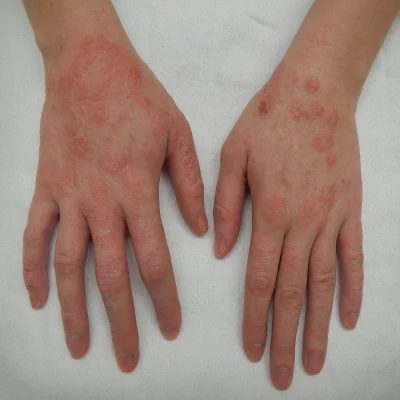مجلات علمية

Overview about impetigo
Impetigo is a contagious bacterial infection of the skin, often affecting children mostly between age of 2 and 6 years, and the infection is concentrated in the upper layers of the skin which mean that it lies in epidermis.[1]
Impetigo is the third most prevalent skin disease in children, and the infection rate is higher in children in tropical regions than in other temperate regions.[2]
The share of impetigo is an estimated 126 million children around the world, and the activity of bacteria increases in warm weather, and it is very old, as it dates back to the fourteenth century in England, where it was named for the first time.[3]
Causative organisms
The common types of bacteria that cause impetigo are staph or strep bacteria, which include several types within these two categories, including staph aureus and streptococcus pyogenes.[1]
Symptoms
We can consider impetigo as a simple bacterial infection that often affects the exposed areas of the skin such as the face (fig 1), especially the area around the mouth and nose, as well as the arms and legs.[2]
There are two types of impetigo, a bullous type and a non-bullous type, which are the most common. Symptoms vary in each patient according to the type of bacteria the patient has, and therefore the type of impetigo:
The first type is bullous impetigo, which appears in the form of skin bubbles or blisters and spreads on the trunk more and ruptures easily and is less common than the second type.[3]
The second type is non-bullous, which is the most prevalent type and usually appears in children, especially around the mouth. It appears in the form of a vesicle and ruptures to leave in its place honey-coloured scales, and then falls off, leaving a red spot in its place that disappears without leaving any scars.[3]
Impetigo is characterized by itching in the existing blisters and the duration of the disease that appears, from infection until symptoms appear, 10 days.[2]
Fever may coincide with impetigo, and the lymph nodes in the body may become larger as a defense, but in rare cases.[1]
Causes
Impetigo may occur as a primary infection of the skin with staphylococcus or streptococcus bacteria. The prevalence of each type varies from one region to another. For example, staphylococcus bacteria are common in temperate climates.
Impetigo may occur as a secondary infection due to the presence of a skin disease that breaks the skin barrier, causing bacteria to enter and cause infection.[1]
How to diagnose?
The diagnosis is made by examining the site of the infection, and the doctor can diagnose without any laboratory tests, but a sample of the fluid in the beast is taken to make a bacteria culture and identify the bacteria causing the disease and then determine the appropriate antibiotic for it by testing the bacteria’s sensitivity to antibiotics. [1]
Treatment
The type of antibiotic is chosen according to the type of the causative organism, and it is also selected based on the size of the infection. For example, when the infection is simple, we can use topical antibiotics such as ointments, and in the case of severe infection, we can start treatment with an antibiotic taken orally.[1]
topical ointments: mupirocin cream or ointment, retapamulin ointment.
Oral medications include amoxicillin/clavulanate and clindamycin.
The treatment usually lasts for a week or a week and a half until the symptoms disappear, and the infection is eliminated, and it may take longer if the infection is severe or includes a larger part of the body.[3][2]
References
https://www.healthline.com/health/impetigo#_noHeaderPrefixedContent
https://www.cdc.gov/groupastrep/diseases-public/impetigo.html
S. Koningvan, R. der Sande, et all, Interventions for impetigo. Cochrane Database of Systematic Reviews, (1). (2012).






